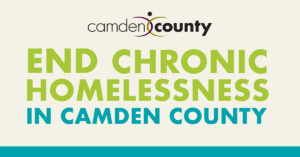 (Camden, NJ) – In order to address the ongoing issue of homelessness across the county, the Board of Commissioners and Camden County Office of Homeless Services have created a six-point plan that utilizes programs and partnerships to combat and eliminate homelessness in Camden County. The plan will be executed with the help of several community partners including Volunteers of America and the Community Planning and Advocacy Council and several other social service providers.
(Camden, NJ) – In order to address the ongoing issue of homelessness across the county, the Board of Commissioners and Camden County Office of Homeless Services have created a six-point plan that utilizes programs and partnerships to combat and eliminate homelessness in Camden County. The plan will be executed with the help of several community partners including Volunteers of America and the Community Planning and Advocacy Council and several other social service providers.
According to the Federal Department of Housing and Urban Development, Camden County has about 600 residents who are dealing with the challenges of being homeless. This number includes individuals who are without shelter and others living on the precipitous of being unsheltered.
“Right now, homelessness is a major issue we are facing here in South Jersey as well as nationwide,” said Commissioner Director Louis Cappelli Jr. “We know what contributes to homelessness and we have enlisted the help of experts to come up with a plan to begin reducing these numbers and get people into stable, supportive housing. By getting someone off the streets or out of tent into supportive housing can have a significant benefit to the community and allow the individual to be in a stable environment and get their feet back underneath them.”
The plan focuses on six key components:
Policy: Lobbying for policy reforms at local and state levels to address systemic issues contributing to homelessness, advocating for the right to housing for all.
People: Collaborating with individuals with lived experiences to craft the most impactful strategies and reduce stigma that plagues the unsheltered in our community.
Partnerships: Promoting engagement and collaboration with all stakeholders, taking a cross-departmental approach to homelessness and creating an internal working group dedicated to working collaboratively to provide services to shared populations.
Prevention: Focusing on preventing homelessness by working with nonprofits who provide resources such as rental and utilities assistance, paying security deposits and motel rooms and finding shelter beds for income-eligible people and families.
Programs: Supporting and partnering with programs to provide mental health support, substance abuse treatment, job training, and education to meet the needs of homeless residents.
Places: Partnering with state, county, and local agencies to address the needs of our unhoused neighbors living in homeless encampments, with a goal of making it possible for them to access shelters and ultimately, live in homes of their own.
Each municipality within Camden County will be involved in the efforts and the goal is to end homelessness and reach functional zero by 2030. Functional zero is reached when the number of homeless people, sheltered or unsheltered, is no greater than the monthly housing placement rate.
“We all share in the ownership of this issue because the struggles of homelessness do not discriminate, anyone can be impacted at any time,” said Robert Jakubowski, director of Camden County Community Development. “It is imperative to have as many people and municipalities on the same page as possible because every community stands to benefit by working together to address the challenges that stem from homelessness.”
The first community in the nation to end chronic homelessness was Bergen County, New Jersey, where functional zero has been sustained for more than three years. One of the individuals who was a principle of the initiative in Bergen County was Julia Orlando and she is now consulting for the Camden County Commissioners to replicate the same pathway to success.
“Collaboration and coordination will be important to aligning the proper resources and ensuring that everyone at all levels of government are pulling in the same direction to get to functional zero,” Orlando said. “Moving forward will be about having the intestinal fortitude and strong leadership to make hard decisions and reach our ultimate objective.”
Anita Wemple, President and CEO of the Community Planning & Advocacy Council, talked about the importance of everyone working together to address the challenges of homelessness.
“Ensuring that we are working in partnership with the Commissioners and providing impactful services to our clients is paramount for us to reach the goal of functional zero when it comes to individuals who are unsheltered,” Wemple continued. “We have a team of talented social service providers and working within the strategy of this six-point plan can help us meet our global objectives here in Camden County.”
Stephen Considine, CEO of Senior Citizens United Community Services (SCUCS) discussed how addressing homelessness through a different, more holistic lens can help reduce the impact of the issue overall.
“With the rising costs of rent, home maintenance and heating costs, many residents are at risk of losing their homes,” Considine said. “By taking a more holistic and comprehensive approach to housing, through services such as the Camden County Tenant Based Rental Assistance Program and the Housing Navigator program, we can address complex housing situations and connect people to more permanent affordable housing, thus reducing the incidence of a recurring crisis and promote the individual’s self-sufficiency.”
According to the National Alliance to End Homelessness, the cost to the community for a chronically homeless person is about $36,000 annually in taxpayer services. When that same person is placed in supportive housing that cost is cut in half and when placed in permanent housing there is a net-benefit to the community.
Learn more: https://www.camdencounty.com/service/end-chronic-homelessness-in-camden-county/
